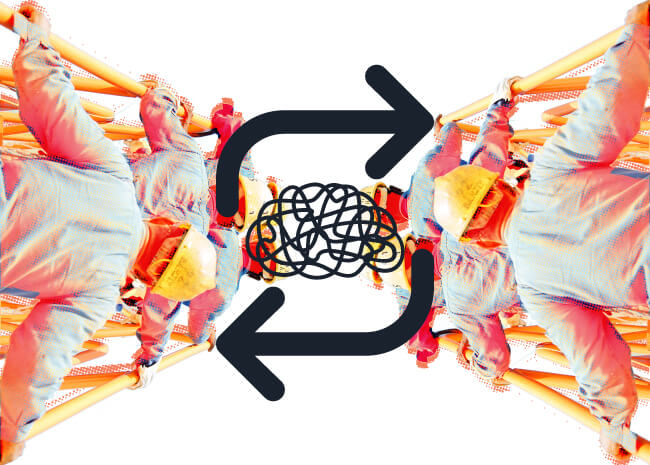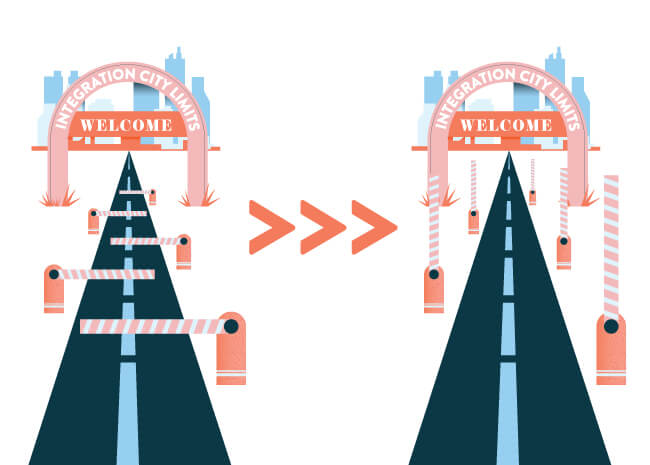Editor's Note: Today we're featuring another excellent author from PAGES magazine — Heather Physioc of VMLY&R!
Heather has the unique experience of managing multiple teams, with multiple specializations, across multiple countries — she knows how to inspire collaboration and integrate multiple disciplines to achieve holistic success. Read on to learn how Heather has built a discoverability powerhouse at VMLY&R and how you can do the same at your company.
P.S. We also had the pleasure of discussing this topic with Heather on a recent webinar, which you can watch in its entirety here.
We as an industry talk a good game on collaboration, but the truth is that it’s not really happening the way we tell our clients or executives that it happens. We waltz into new business pitches and make big claims about how “integrated” we are and how we “sit right next to” the people we work with on other teams. We preach that our recommendations are better because we have a more “holistic” offering. But whether it’s across agencies working on the same client, different teams working within the same agency, or different teams in-house on the client side, collaboration is much harder to achieve in reality than we make it look on the outside.

More often than not, experts get sucked into their respective silos, buried by the day-to-day task lists of their jobs, focusing on their own areas of expertise. Agencies write SEO scopes and PPC scopes separately, often without accounting for content resource needs to make the channels successful. Companies bring recommendations forward to executives that don’t have buy-in from our peers. We don’t bring each other in, but then complain that we are not being brought in.
Learnings from multiple mergers
My company has gone through many mergers and acquisitions over the years, and just in the last three years we have merged with three other agencies in our network. Most recently, we were an agency that had enormous e-commerce capabilities and a long-time partner and iconic brand-building agency. We effectively doubled in size to more than 7,000 employees and tripled our global footprint overnight to more than 90 offices worldwide. With those mergers came tons of complementary skill sets and client lists we could do great work for.

Through the mergers, we had presented to us a unique opportunity to solve chronic resource and collaboration problems by bringing the organic search, paid search, and performance content teams together under one unified umbrella.
Now our Discoverability group is 30 people in four offices across North America, and we’ve helped our global colleagues in South America and Europe establish stand-up search practices too.
With all this change and merging of teams, we had some hard choices to make and hard work to do to make this integration of different capabilities and cultures successful.
Introducing Interdisciplinarity
Enter the concept of interdisciplinarity. It’s an academic term describing when two or more schools of thought join forces to solve more complex problems as new needs emerge. It’s when they combine and break traditional boundaries to solve shared challenges, benefiting from integrating and updating their individual approaches into a new, holistic approach. Interdisciplinarity is said to help solve for the detracting effects of excessive siloing and specialization.
In the rapidly evolving and increasingly commoditized field of search, executives and practitioners alike need to be thinking about this.
We tend to see interdisciplinarity happen in well-known technical and scientific fields. Think neuroscience, biochemistry, cybernetics. While search may not be curing cancer, there is new ground to be forged in our industry.

There is a key difference between complementarity and interdisciplinarity. Just about anyone can go online and learn SEO. Anyone can learn PPC. Plenty of companies do “complementary” search work - perhaps sitting next to one another and at least not contradicting one another’s work.
But few do truly interdisciplinary work - offering new, evolved capabilities in search. In the next five years, interdisciplinarity will be the difference between companies with competitive edge, and companies that stagnate.
True interdisciplinarity is when the sum of the whole is greater than its parts. It’s the Gestalt of bringing distinct specialties together to create a completely custom solution for a problem. It’s situational - people with relevant expertise bring unique knowledge and experiences for a more cohesive, end-to-end offering that is bespoke for the need. But it’s repeatable and refinable as more problems come along.
This concept is a driving force that has guided our way through merging teams. Everything we do has focused on leveling up. And now we help clients in complex organizations do it, too. This is more than enhancing our implementation of SEO and PPC. This is about helping companies evolve the ways in which they think about and deliver on the promise of search.
Why bother with integration?
With professionals who have been smart and successful independently, why should we go to the trouble of moving away from separate swim lanes to one cohesive, unified group? And equally important, how?
Greater advocacy
The majority of our growth typically comes from better serving and expanding existing relationships, not winning big chunks of new business. You go from a select few team members on different teams advocating for their own work, to a combined force of all the team members advocating for all of each other’s work.
More cross-selling & upselling
An integrated team finds it easier to cross-sell and upsell when clients get stuck on related resources. Merging has allowed us to shift budget seamlessly between teams based on demand, offer pilots of the other services to our clients, show our chops, and prove outcomes we can earn. We can also talk to our clients about dominating whole search pages by seizing every space possible.
Increased speed & scale
Having an integrated team with areas of overlap allow leaders to better distribute labor across the team. For example, our performance content team now writes SEO metas and PPC ad copy. Our paid and organic search teams are conducting keyword research and competitive analysis together, reducing duplication of effort. We’re dividing and conquering to cover more research ground more quickly and share learnings from our own areas of expertise, delivering a stronger product and speeding it up by weeks.
A culture of knowledge sharing
Data sharing becomes second nature to an integrated team. It helps you find opportunities you wouldn’t have spotted before. A deeper and wider pool of knowledge builds a deeper and smarter bench. It takes a culture of crowd sourcing and sharing where no one feels the pressure to know everything. We solve problems faster by pooling our knowledge.

Minimize cannibalism and competition
When individual teams have individual objectives, it runs the risk of being “every team for themselves.” But ultimately, the company or client is held to a single-growth target. A joined team can help people stop worrying about whose budgets and targets are whose, and instead focus on what’s best for the business. It allows you to steer resources to where the greatest impact will be felt. It doesn’t matter so much which channels deliver - as long as they do.
Increased credibility
Recommendations have more weight and credibility together when they’re vetted from multiple experts. Experts should talk about joint opportunities, the ways in which channels perform together and separately, balances paid, and organic recommendations. The more thoughtful approach is more easily defensible to a client or a board. Demonstrating more bang for the marketing buck makes it easier for clients and bosses to say yes and invest.
Identifying new capabilities
You will find that by integrating different specialties, you are likely to develop new capabilities at the intersections between those practices. This enables you to build and launch new, unified services that increase the value we can add for clients. In our case, this led to an end-to-end digital shelf optimization, offering enhanced landing page development, for example.
Create competitive advantage
True interdisciplinarity is difficult to accomplish, so it’s hard for competitors to replicate. Competitive advantage happens when you put in the legwork that competitors can’t, don’t, or won’t. Mastering integrated services can give you unique points of distinction that competitors simply don’t have, and you become increasingly indispensable to your clients or organization.
Risks and roadblocks to integration
There will be no shortage of risks, roadblocks, and obstacles to integrating teams. The following are some you can anticipate as a driver of change.
Moving from theory to reality
As practitioners, we have deluded ourselves into thinking we collaborate well for so long, it’s easy to become complacent and fail to see how things could be any better. As leaders, we have to make the case for the benefits of working together. As a group, we have to agree on the importance of getting into rooms, working on actual projects together, and proving outcomes through case studies. It’s a massive cultural shift to change from individual athletes on three different teams, to a single, all-star, world-champion team. It doesn’t happen overnight.

Risk of becoming less agile
Counterintuitively, the larger the team, the harder it is to collaborate, especially when the team does several different things. Integration runs the risk of becoming a behemoth so big that we sacrifice our ability to move quickly. It’s easy to fall into the trap of trying to force adoption of one team or the other’s way of doing things, or to collaborate constantly on everything. But we quickly learned that design-by-committee doesn’t work, and we can’t force it. Group identity doesn’t negate the need for autonomy. In fact, interdisciplinary teams fail without being able to maintain their identity and autonomy, or being empowered to make decisions that are right for their team and clients. Now we keep the connective tissue that bonds us as a group, but allow for “slicing and dicing” into smaller teams to serve any need in order to combat the problem of getting too big to stay nimble.
Negotiating roles and defending turf
When integrating teams, conflicts are inevitable. Whether it’s perceived competition for diminishing budgets, or vying for the final say on a course of action, with teams of very smart people in different areas, there is bound to be some negotiating of roles. Maybe even turf-defending. But through integration, we all share the same turf. It takes extra effort to give the benefit of the doubt, assume good intent, and get on the same page. It’s an exercise in humility to give everyone’s expertise equal weight and actively seek perspective instead of it being an accidental afterthought. You have to create a culture where everyone wins when one of us wins.
Complexity of merging processes
Merging processes that worked reasonably well is a common challenge. Each team has its own way of doing things, so they can be resistant and slow to change. You may encounter conflicting expertise and opinions. It’s important to understand each team’s process thoroughly before ripping them apart and sewing them back together - take the time to know why things are the way they are.
Change fatigue
A constant barrage of non-stop change struggles to stick. It’s too much for people to absorb and adopt. It causes them to burn out and lose interest because it feels like there’s no light at the end of the tunnel. Companies that have a culture of ongoing testing, learning and optimization, and change as the norm expected for growth, tend to fare well in the face of change - but everyone has their limits.
Tips for Integration Success
Now that you are going into the process of integrating other teams with search, informed on the risks and rewards, refer to the following tactical tips to get it right.
Announce change quickly
Move quickly to announce the change and inform the teams. Make it clear what you’re doing and why, make the case for the benefits, and be honest about the challenges to get buy-in. Get the teams involved in the mission as soon as possible. Set the expectation that we sink or swim together. The most successful people in the face of change are those who don’t waste time obstructing the inevitable, but instead roll up their sleeves and look for ways to help.
Introduce and immerse immediately
Once announced, rapidly take action to bring the teams together and activate. Get people in the room face to face as early and often as possible, and start a dialogue about a common mission and vision. Work together to brainstorm ideas on how to move forward. Our integration sessions included introductions and icebreakers, overarching sessions about the department and teams, capability and case study sharing, and team-building exercises. Once you have established the new team or process, reintroduce the team to the organization to put faces with names, and educate others on what the new group is capable of and responsible for.
Implement change jointly and steadily
Announce and immerse quickly, but slow down in order to speed up when beginning to implement the changes. Don’t try to boil the ocean - focus on 1% changes one change at a time at natural points of intersection or moments of friction. Give ownership of different initiatives to people from each side to make sure you’re considering all the angles, which helps with buy-in across the group. Charge everyone with making it successful.
Also, try to make early changes iteratively and at natural points of friction at first, so change actually feels like a relief. For example, every SEO can relate to being left out of the content process where keyword research is an afterthought, if it happens at all. One simple change - adding keywords and questions to a new content brief prior to creating content - makes both writers’ and SEOs’ jobs easier. Bonus, small wins can build momentum and endurance for more change.
No process is precious
Process is supposed to be a flexible framework, not a rigid set of rules that stifles innovation. Commit to establishing clear processes that incorporate key search and content stakeholders, and bring those voices to the table to collaborate in creating and refining workflows. Create a living wiki to document recurring processes, which reinforces the message of steady evolution. Update and reorganize them regularly - everyone on the team should have access and trust to refine them. Finally, check in periodically on what isn’t working and discard what doesn’t serve you.
Cross-train to build advocacy
Conduct cross-trainings both in immersion and continuously over time. The intent is not to be able to do each other’s jobs necessarily, but rather to be able to speak about them, advocate for them, and cross-sell them. We’ve done workshops, hands-on training, and even short-term job swaps like having SEOs write e-commerce product detail pages. It creates empathy, builds trust, and makes it easier to advocate for each other’s work. It helps create mental checks for search experts to ask, “Am I including the right people?” or content writers to ask, “Can someone else add value here?” Make it a habit for your group by course correcting people when they forget, and validating and rewarding when they get it right.

Productize service offerings
As your team develops all-new joint services and processes, appoint small, cross-team committees to productize those offering. They should clearly articulate the service, define the value, identify inputs and outputs, and configure ballpark costs and timing. These should be simple packages that can be “pulled off the shelf” when a relevant opportunity arises. For our team, these included things like search-driven content insights to support big campaigns, an end-to-end ecommerce discoverability process, and website rebuilds and redesigns.
Recommend and report together
Integrated search and content teams should be recommending and reporting together. It sounds simple, but it’s rarely done well. Too often, experts regurgitate data in a silo and then smash some slideware together. Instead, require them to compile and discuss their data together to identify the story the information tells, and how they can make decisions across channels to optimize. It helps them build a joint roadmap and prioritize where to focus for the biggest opportunities.
Monthly account strategy sessions
It’s easy to retire to our individual corners and get stuck in the status quo, where departments don’t talk to each other. These account strategy sessions are bigger than a task list - they are a time to collaborate, share what’s happening, and talk about the future. Discuss how the brand is performing in each channel, problems the search and content experts are solving, opportunities we see, big risks or threats, and potential joint efforts, tests, or case studies. This simple meet-up model can benefit any group you’re trying to collaborate with. Establish recurring round tables between search and other departments or global regions.
Build a Networked Team
As your teams grow in size, geography, and complexity, consider moving to a “networked team” model. A networked team has central sources of truth and process, but the operations and execution are decentralized. You have common standards and best practices, but a networked team delivers how they need to. It’s a balance of centralized control and local team empowerment.
Create a Culture of Feedback
When merging search and content teams, coaching and direct, immediate feedback greatly speeds integration. Make transparency and accountability a part of your group’s culture. This means providing feedback to each other and feedback to you. It means peer reviewing each other’s search and content work. It means scrutinizing your shared processes and ways of working. It makes the discoverability work stronger and reduces the margin for error. Setting the expectation makes feedback less personal and more about the quality of work.

Market Collaborative Successes
Marketing success can be a major driver of integration across discoverability teams. You should always look for wins (or warnings) to create case studies. Find meaningful wins that cross teams, and make sure your team, clients, bosses, and colleagues hear these stories. It increases buy-in, understanding, and engagement with your newly-integrated group.
Sit Together When Possible
Who you sit with matters. Put your search and content experts together as much as possible. Turn around their chairs to make it easy to strike up a conversation about things they’re working on and ask questions of each other. While rearranging the floor plan isn’t in the cards for everyone, or people collaborating in different cities or companies, look for every possible opportunity for human contact. That means video chat, traveling for in-person meetings, desk drive-bys, spending part of your day parked with colleagues in their part of the office, real-time instant messaging or phone calls. Basically, whatever it takes to be present and engaged with people in other disciplines.
Integration is the future of search and content
To quote my colleague, Britt, “As individual teams, we’re experts. As an integrated practice, we’re a powerhouse.”
Selling whole, end-to-end services that have greater impact together than separately makes us more indispensable to clients who can’t imagine going back to the disjointed world of before. Combining and evolving our search and content capabilities into one discoverability group makes us stand out from the competition.
The cultural shift is massive - but worth it. It’s an iterative process with plenty of growing pains along the way. Even if it doesn’t make sense to reorganize or merge teams, it does make sense to break down barriers between other disciplines. These steps can help integrate search with any other department. It could be creating a competency circle around a certain type of work or client that transcends your org chart. As time goes on, new things are created, the group and its processes mature, and the lines between them start to blur. When your new culture is established, hire and promote for the traits to sustain it, like communication, being a team player, collaboration, accountability, transparency, and empathy.
There will be bumps along the way. It can be frustrating and time consuming up front. People won’t always agree and conflicts will happen. As a leader of discoverability in your organization, you can create a culture of openness, vulnerability and feedback. You can create the expectation of iteration, evolution, and change. You can have the fortitude to push through obstacles together and forge something entirely new.
Remember that competitive advantage comes from doing the work your competitors can’t, don’t, or won’t. Because if it were easy, everyone would do it.

